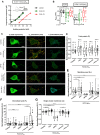Smoothened receptor signaling regulates the developmental shift of GABA polarity in rat somatosensory cortex
- PMID: 32989040
- PMCID: PMC7595691
- DOI: 10.1242/jcs.247700
Smoothened receptor signaling regulates the developmental shift of GABA polarity in rat somatosensory cortex
Abstract
Sonic hedgehog (Shh) and its patched-smoothened receptor complex control a variety of functions in the developing central nervous system, such as neural cell proliferation and differentiation. Recently, Shh signaling components have been found to be expressed at the synaptic level in the postnatal brain, suggesting a potential role in the regulation of synaptic transmission. Using in utero electroporation of constitutively active and negative-phenotype forms of the Shh signal transducer smoothened (Smo), we studied the role of Smo signaling in the development and maturation of GABAergic transmission in the somatosensory cortex. Our results show that enhancing Smo activity during development accelerates the shift from depolarizing to hyperpolarizing GABA in a manner dependent on functional expression of potassium-chloride cotransporter type 2 (KCC2, also known as SLC12A5). On the other hand, blocking Smo activity maintains the GABA response in a depolarizing state in mature cortical neurons, resulting in altered chloride homeostasis and increased seizure susceptibility. This study reveals unexpected functions of Smo signaling in the regulation of chloride homeostasis, through control of KCC2 cell-surface stability, and the timing of the GABA excitatory-to-inhibitory shift in brain maturation.
Keywords: Chloride homeostasis; GABAergic transmission; KCC2; Smoothened receptor; Sonic hedgehog.
© 2020. Published by The Company of Biologists Ltd.
Conflict of interest statement
Competing interestsThe authors declare no competing or financial interests.
Figures








Similar articles
-
Contribution of Smoothened Receptor Signaling in GABAergic Neurotransmission and Chloride Homeostasis in the Developing Rodent Brain.Front Physiol. 2021 Dec 10;12:798066. doi: 10.3389/fphys.2021.798066. eCollection 2021. Front Physiol. 2021. PMID: 34955901 Free PMC article. Review.
-
Subcellular localization of Patched and Smoothened, the receptors for Sonic hedgehog signaling, in the hippocampal neuron.J Comp Neurol. 2011 Dec 15;519(18):3684-99. doi: 10.1002/cne.22681. J Comp Neurol. 2011. PMID: 21618238 Free PMC article.
-
A novel protein encoded by circular SMO RNA is essential for Hedgehog signaling activation and glioblastoma tumorigenicity.Genome Biol. 2021 Jan 14;22(1):33. doi: 10.1186/s13059-020-02250-6. Genome Biol. 2021. PMID: 33446260 Free PMC article.
-
Hedgehog-signaling is upregulated in non-producing human adrenal adenomas and antagonism of hedgehog-signaling inhibits proliferation of NCI-H295R cells and an immortalized primary human adrenal cell line.J Steroid Biochem Mol Biol. 2014 Jan;139:7-15. doi: 10.1016/j.jsbmb.2013.09.007. Epub 2013 Sep 21. J Steroid Biochem Mol Biol. 2014. PMID: 24063979
-
Understanding Abnormal SMO-SHH Signaling in Autism Spectrum Disorder: Potential Drug Target and Therapeutic Goals.Cell Mol Neurobiol. 2022 May;42(4):931-953. doi: 10.1007/s10571-020-01010-1. Epub 2020 Nov 18. Cell Mol Neurobiol. 2022. PMID: 33206287 Free PMC article. Review.
Cited by
-
Pax6 limits the competence of developing cerebral cortical cells to respond to inductive intercellular signals.PLoS Biol. 2022 Sep 6;20(9):e3001563. doi: 10.1371/journal.pbio.3001563. eCollection 2022 Sep. PLoS Biol. 2022. PMID: 36067211 Free PMC article.
-
A Potent Antagonist of Smoothened in Hedgehog Signaling for Epilepsy.Int J Mol Sci. 2022 Nov 22;23(23):14505. doi: 10.3390/ijms232314505. Int J Mol Sci. 2022. PMID: 36498832 Free PMC article.
-
When Are Depolarizing GABAergic Responses Excitatory?Front Mol Neurosci. 2021 Nov 24;14:747835. doi: 10.3389/fnmol.2021.747835. eCollection 2021. Front Mol Neurosci. 2021. PMID: 34899178 Free PMC article. Review.
-
Contribution of Smoothened Receptor Signaling in GABAergic Neurotransmission and Chloride Homeostasis in the Developing Rodent Brain.Front Physiol. 2021 Dec 10;12:798066. doi: 10.3389/fphys.2021.798066. eCollection 2021. Front Physiol. 2021. PMID: 34955901 Free PMC article. Review.
-
Establishing Hedgehog Gradients during Neural Development.Cells. 2023 Jan 5;12(2):225. doi: 10.3390/cells12020225. Cells. 2023. PMID: 36672161 Free PMC article. Review.
References
-
- Aguado F., Carmona M. A., Pozas E., Aguiló A., Martínez-Guijarro F. J., Alcantara S., Borrell V., Yuste R., Ibañez C. F. and Soriano E. (2003). BDNF regulates spontaneous correlated activity at early developmental stages by increasing synaptogenesis and expression of the K+/Cl− co-transporter KCC2. Development 130, 1267-1280. 10.1242/dev.00351 - DOI - PubMed
Publication types
MeSH terms
Substances
LinkOut - more resources
Full Text Sources
Miscellaneous

